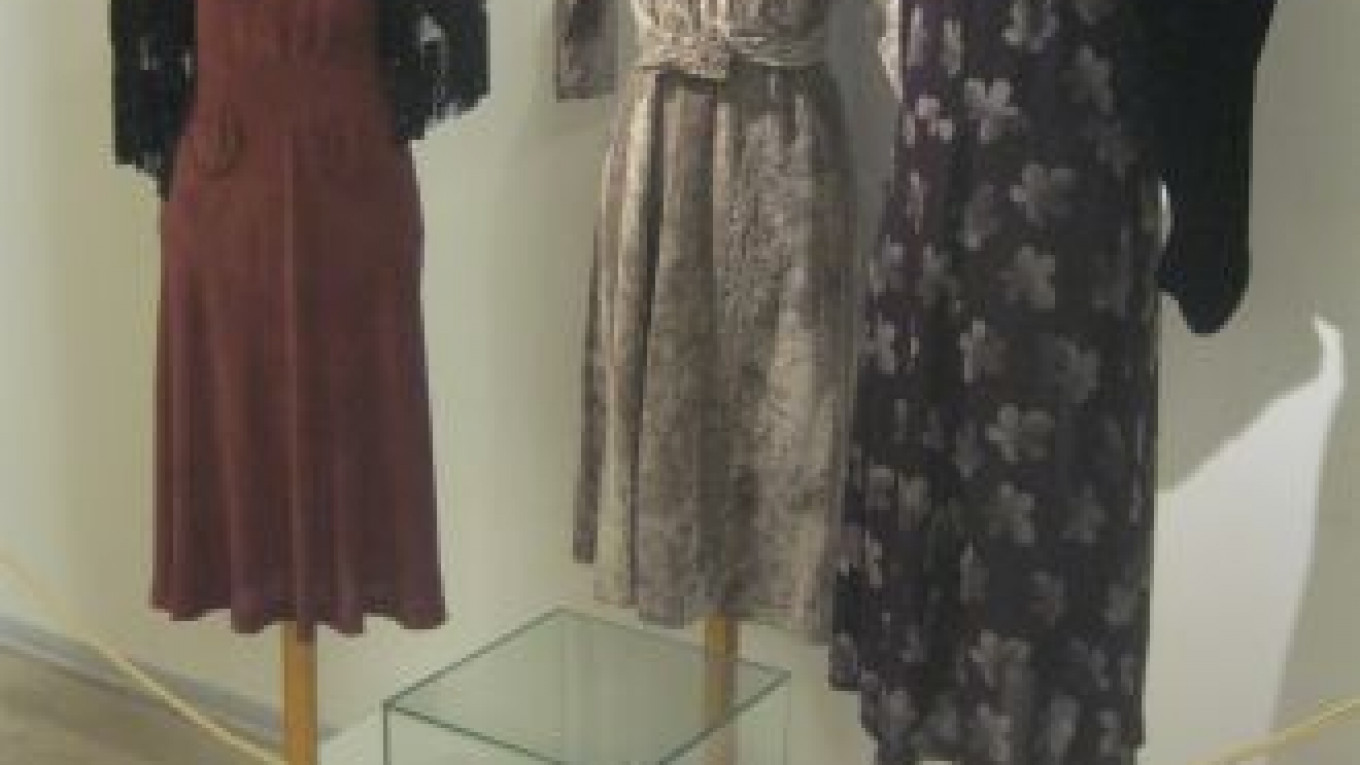ST. PETERSBURG — How can you make a fashionable coat when the only fabric available is a piece of coarse felt used to make military overcoats? A possible solution — accompanied by spirited sewing patterns — can be found in the old, yellowing pages of a fashion magazine published in Russia in the 1920s.
"If you have a piece of cloth about two meters wide, cutting a one-piece seamless coat is a good idea," the journal suggests. "We'll only make cuts for the armholes. The sleeves will have one seam, while the collar will have the shape of half a square."
The newspaper spread is part of a small yet overwhelming exhibit at the Konyushenny Wing of the Yelagin Palace. Titled "Models of the Season 1927-53. Fashion Press From the Stalin Era," the collection — which occupies a single hall on the second floor of the building — provides for a captivating yet sobering journey through the lives of Russian women just before, during and after World War II.
On show, accompanied by Stalin-era documentaries projected onto the wall, are newspaper and magazine spreads with fashion advice, sketches and sewing patterns on how to craft black lace gloves, a demure dark blue dress with a lacy collar and a chic velvet dress topped with a luxurious silver fox stole tied with black silk ribbons. The display also includes a bottle of the iconic Stalin-era perfume, Krasnaya Moskva (Red Moscow) — a legend in itself — which embodies the scent of fashion and was coveted by millions of Russian women. Most of the pieces come from the private collection of local fashion historian Megan Virtanen, who came up with the idea of the exhibit.
Virtanen's display is a much-needed softer addition to the traditional fare of exhibitions mounted every year to mark the May 9 Victory Day public holiday. Memories of the war consist of far more than images of bloodstained military uniforms, bullet-ridden helmets and deadly weapons — however compelling a story these items might convey.
A credible story about winning a war and surviving its horrors is impossible without a few lines on what made people smile and helped them to keep their chins up by providing them with moments of relief and happiness amid the devastation.
And in this respect, Virtanen's display is a valuable addition to the palette.
At the heart of the exhibition is Virtanen's collection of fashion magazines. One truly amazing edition from October 1942 features fashion designs created in Leningrad, already under siege at the time.
A 1940s edition of the Models of the Season magazine offered a spread dedicated to what its editors described as "garment designs suited to wartime needs." The designers suggested women turn to thick cotton fabrics, use zippers and make more trousers. The designs included a variety of "self-defense" outfits, which were designed to make movement and protecting oneself easier in the event of an emergency situation. Such practical advice contrasts starkly with the glossy magazines from the 1930s, in which brightly-colored cocktail and party dresses danced across the pages.
Most Soviet fashion publications made sure to include pages showcasing international fashion trends. After the war, many women were keen to go ice skating — an affordable and entertaining pastime and a cheerful winter alternative to the traditional dances. The country's fashion magazines responded to the trend with a series of sketches of woolen skating outfits. The designers recommended "a straight skirt, with a single deep front pleat and a straight jacket with a waist belt."
In her everyday life, Virtanen, whose interest in Stalin-era fashion evolved from a keen interest in prewar jazz, is a strict follower of 1940s fashion in her own wardrobe.
The collector and historian organized a preview event for her exhibition in the form of a 1945 fashion show. Held in the courtyard of the Konyushenny Wing, not professional models but ordinary local women paraded down the runway in clothes and accessories from their own collections from the World War II era. Some of the items were inherited from older family members, some purchased in antique shops and others found at flea markets. Each participant gave a short personal introduction, telling the audience about the origins of a certain dress, a pair of gloves or a hat.
During the course of the exhibit, which ends June 30 with a typical dance a la 1945, Virtanen will give three lectures about Soviet fashion.
"Models of the Season 1927-53. Fashion Press From the Stalin Era" runs till June 30. Konyushenny Wing. 4 Yelagin Ostrov. Metro Krestovsky Ostrov. Tel. +7 (812) 430-1131.
A Message from The Moscow Times:
Dear readers,
We are facing unprecedented challenges. Russia's Prosecutor General's Office has designated The Moscow Times as an "undesirable" organization, criminalizing our work and putting our staff at risk of prosecution. This follows our earlier unjust labeling as a "foreign agent."
These actions are direct attempts to silence independent journalism in Russia. The authorities claim our work "discredits the decisions of the Russian leadership." We see things differently: we strive to provide accurate, unbiased reporting on Russia.
We, the journalists of The Moscow Times, refuse to be silenced. But to continue our work, we need your help.
Your support, no matter how small, makes a world of difference. If you can, please support us monthly starting from just $2. It's quick to set up, and every contribution makes a significant impact.
By supporting The Moscow Times, you're defending open, independent journalism in the face of repression. Thank you for standing with us.
Remind me later.






